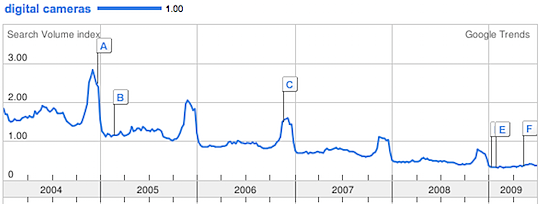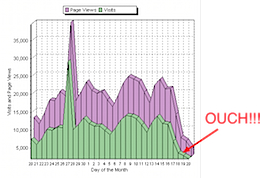6 Reasons Your Blog Traffic Might Be Declining [And What to Do About It]

Over the last few days I’ve read a few comments here on Problogger from bloggers who are feeling low because they’ve noticed a plateau or even a decrease in the traffic coming to their blog.
While we all want to see our traffic rise the reality is that every blog has days, weeks and even months where traffic levels out or even decreases. This can be quite distressing for bloggers who have big hopes and dreams for their blogs.
Today I’d like to look at some of the reasons a blog’s traffic might decrease and suggest some ways forward for each of them.
1. Seasonal Traffic
If you’re still in the first year of your blog you are yet to see what a full calendar year looks like in terms of traffic for your niche. Most niches have natural rises and falls in traffic.
For example (see below for a chart of visitor numbers) on my photography tips blog we see spikes in traffic in December and January. December’s traffic boost is generally to do with people researching new cameras to buy and January is generally associated with people working out how to use cameras that they got for Christmas. On the flip side we often see dips in traffic over August to October.

What to Do: The first time you see a seasonal rise or fall in traffic it can be quite confusing - however the key with it is to not panic when you see a dip but to identify opportunities to maximize the rises and to minimize the falls.
For example it might be that you need to tailor your content for certain times of year and what people are doing in relation to your niche.
For me on my photography blog this meant writing content in November-December on how to buy a digital camera (to capitalize on the Christmas buying trend), writing beginner photography tips in January (to capitalize on the trend of people looking for tips on how to use their new cameras) and during low seasons (like July when it’s summer in the US) writing topical tips like Beach Photography Tips or How to use a camera in the Bright Sun.
Another Tip - one great free tool for looking at seasonal traffic is to use Google Trends to analyze what people are searching the web for. For example if I type in ‘digital cameras’ I get this chart:

There’s lots of interesting stuff in this (the downward trend for starters) but it clearly shows what I’ve observed above - more people are searching the web for that term from November-December each year. This information could confirm a suspicion you have or help you identify a trend to capitalize on in your niche.
Further Reading: Seasonal Traffic and How to Capture it for your Blog.
2. Topical Interest
 At other times of year traffic events can be triggered by other current events. For example I know one music blogger who has had a lot of traffic this past few weeks simply because they’d previously had a lot of content that ranked well in Google on Michael Jackson. Of course in coming months as the news of Jackson’s death subsides it’s likely that they’ll see some declines in traffic.
At other times of year traffic events can be triggered by other current events. For example I know one music blogger who has had a lot of traffic this past few weeks simply because they’d previously had a lot of content that ranked well in Google on Michael Jackson. Of course in coming months as the news of Jackson’s death subsides it’s likely that they’ll see some declines in traffic.
What to Do: The key with topical rises and falls in traffic is to try to capture as much of the rush of traffic as you can so that when the decline comes you’ve got new subscribers/readers to your blog (see further reading below on ’sticky blogs).
It’s also important to be aware of upcoming events in your niche and writing content in anticipation of that. This can be hard in predicting the death of a mega pop star like Jackson but in different niches it’s possible to predict events.
For example - before the Athens Olympics I was involved in running a blog where we wrote a post in advance of the Olympics for every single event in the games. The posts included athletes names and any information we could get on the events. We updated the posts with results once they events had been run. As a result we were consistently ranking very highly for ‘Event name Results’ when people were searching for winners of events in Search Engines.
Further Reading: How to Create a Sticky Blog
3. Posting Frequency
 One common reason for lulls in traffic is that a blog has had a lull in new content being published. I saw one blogger writing a post recently about how their blog was failing to gain traction and in the comments of the post a reader pointed out that the blogger had hardly been posting. The reality was that the blogger had produced very little to be read and so people were not visiting.
One common reason for lulls in traffic is that a blog has had a lull in new content being published. I saw one blogger writing a post recently about how their blog was failing to gain traction and in the comments of the post a reader pointed out that the blogger had hardly been posting. The reality was that the blogger had produced very little to be read and so people were not visiting.
What to Do: Posting more doesn’t guarantee extra traffic but it can be a factor to consider. Chart your last few months of posts and see if there’s any correlation to rises and falls in your traffic - you might identify a trend!
Worth noting is that some bloggers report that when they post LESS that they actually get more traction with readers. I know of one blogger who was posting 10-20 times a day and when he dropped things back to 2-3 posts a day he noticed not only increases in comment numbers per post but that his posts were being shared more on social media sites. At 10-20 posts a day posts were coming off the front page of his blog so much that readers hardly had a chance to read and share them.
Further Reading: What is the Ideal Post Frequency for a Blog?
4. Shifts in Search Rankings
Many blogs see the way that they are ranked by Google (and other search engines) rise and fall over the years. 
A Personal Example - Back in 2004 (just before Christmas) I woke up one day to find that my main blog at that time had all but disappeared from Google. I’d not done anything to the blog that wasn’t allowed by Google and hadn’t made any major changes to the site - I just disappeared. My heart sank (actually I felt quite sick) because that blog was the main source of income from my blogging and 75% of my traffic had vanished.
The lull in traffic lasted about 6 weeks before it magically reappeared. In that time I got myself another job and diversified my blogging and learned a lot.
What to Do: Sometimes search engines change their algorithms and occasionally they seem to lose sites from their rankings for no apparent reason. The key with this type of loss of traffic is to not panic, make sure you’re abiding by Google’s guidelines (not selling text links or doing anything else considered to be black hat) and then apply for re-inclusion using Google’s webmaster tools.This has happened to me a couple of times over the years and each time the traffic came back - it wasn’t quite as good as when it disappeared but things seemed to right themselves.
Further Reading: Search Engine Optimization for Bloggers
5. Poor Quality Posts
 Of course another factor to consider when looking at the traffic to your blog is whether you’re actually building a valuable site for readers and producing high quality, engaging and useful content.
Of course another factor to consider when looking at the traffic to your blog is whether you’re actually building a valuable site for readers and producing high quality, engaging and useful content.
This one can be a little confronting to think through and might take you getting an outsiders critique or feedback (sometimes it’s hard to be objective about something you’ve put so much work into). As I look back on my own blogging I know there have been definite times where traffic has suffered when I’ve struggled for inspiration as a blogger and where this has impacted the quality of what I was able to write.
On the flip side there have been times where I’ve been inspired to write series of posts that have connected with readers and helped them in practical ways which has driven a lot of traffic to my sites.
What to Do: Ask yourself (and others around you):
- Are You Being Relevant and Useful to Readers?
- Is your blog helping your readers by providing them with value, solving their problems, entertaining them or giving them a sense of community?
If the answer is no then it is likely to impact the number of people reading it.
Further Reading: How to Write Great Blog Content
6. Promotional Activities
 As I look at some of the rises and falls in traffic to my blogs I know that some of them can be directly tied to my own marketing and promotion of my blogs (or the lack of promotion that I’ve done).
As I look at some of the rises and falls in traffic to my blogs I know that some of them can be directly tied to my own marketing and promotion of my blogs (or the lack of promotion that I’ve done).
Writing great content doesn’t guarantee a blog’s success. You can’t just build it and expect that ‘they will come’. Sometimes you need to get out there and promote yourself.
Perhaps the lull in traffic on your own blog is partly to do with taking your foot off the accelerator in your own marketing.
What to Do: This means different things for different blogs but could include investing into social media sites like Twitter, promoting your posts to other bloggers, networking with other bloggers, running a competition on your blog, leaving comments on other blogs and forums, guest posting on other sites, doing promotions in main stream media, doing some giveaways….. etc
Further Reading: How to Find Readers for Your Blog.
Keep Moving Forward - Don’t Give Up
There are many other potential factors that could be at play (I invite you to share others below) but the key is to not be paralyzed by the declines and plateaus in traffic that you experience but to spend a little time trying to identify the reasons and then keep on motoring on with your blog.
You can see from the first chart above that my photography blog has had quite a few months where traffic has plateaued and dipped - but I’ve kept to the vision that I have for the site and continued to keep working. A decrease in traffic from one month to the next is not pleasant but it’s not the end of your blog. If I’d allowed the dips to determine whether I’d keep blogging or not I’d probably have lasted 2-3 months on that blog and failed to see it grow to the point that it has.
1 comment:
в итоге: отлично. а82ч
Post a Comment